Threads In Tyme, LTD | home
History of Colors
History of Colors
Examples of various Blues from the 1825 to 1875:
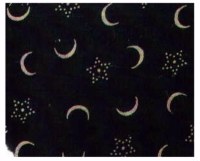
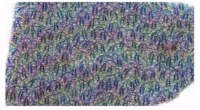
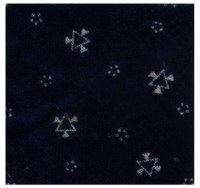
Red Colors From Between 1830 to 1840
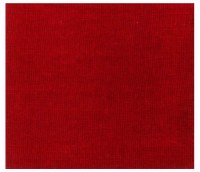
TURKEY RED
(called so because the color originated in the Eastern area of the Mediterranean region. There were between 13 to 20 steps to manufacture the color Turkey Red. The result was that it was colorfast AND very expensive. Turkey Red is bright with a slightly blue tint. The early pieces were a solid color. Between 1840 and 1870 had a the mid century prints had a Turkey Red back ground and included Black, Yellow, Blue and Green figures. Most of this line was imported from Europe, if not all. This red color is seen in quilts between 1840 to 1870 but can rarely date to 1900.
There were several shades of red that was used by quilters. One of these was Turkey Red. A few of the characteristics of Turkey red wear are:
Turkey Red wears thin as a direct result from surface abrasion and becomes lighter in the high relief areas of the quilt.
The color remains dark and the fabric stays intact in the low relief areas near quilting and the seam areas.
As the Turkey Red wears it becomes streaked with white rather than fading to a uniform pink or brown.
In plains and prints Turkey Red became a staple in clothing and quilts between the 2nd quarter of the 19th century and lasted until the end.
During World War I caused the importation of German goods (The Turkey Red was an imported product from Germany) to cease. The British embargo on German goods caused the fast reds to almost disappear.
QUESTION: Did you know that TURKEY RED Calicoes with tiny cones, flowers and geometrics appeared at the beginning of the 19th century and were used in scrap quilts?
QUESTION: Did you know that Turkey Red were the characteristic color in applique quilts from the 1840's on?
INTERESTING FACT: By the mid 19th century the color Turkey Red was produced by printing black, yellow, blue and green figures? Some of these have rotten away due to the caustic dyes and chemicals that were used in the discharge process?
INTERESTING FACT: Turkey Red cost more to produce than other red colors? This is because the Turkey Red was a process than a mere dye. The name Turkey Red was some times used to misrepresent synthetic red dyes. Housewives could purchase package dyes that were labeled "Turkey Red". The packet contained a less reliable dye that was known as "Congo Red". Congo Red produced a bright red color that soon faded to brown and then to a pink.
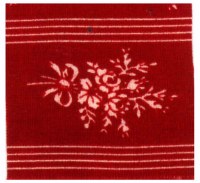
MADDER RED
(named after the root of the Madder plant which was boiled and boiled until the plant gave up its deep red color. The root produced between red/brown through cinnamon/orange shades of red. There were two types of red prints produced through 1875 one was named a "Paisley" (possibly named after Paisley shawls). The other was common and inexpensive of a black figure on a red madder background.
HELPFUL HINT in dating quilts in the second shade of red is a cinnamon red that was also termed "Madder Red". When you see actual madder red it has an orange tinge and thus is easy to distinguish between Turkey Red and Madder Red. Remember that Turkey Red has a bluish cast.
Madder Red is found in Chintzes and calico cottons as well as wool, silk and linen and combination prints. These were popular in the last half of the 19th century.
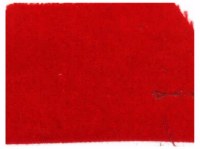
This color is a different shade of red than the earlier ones. It has an orange cast when compared to the "blueish Turkey red". This color played an important role in the changing color schemes of the twentieth century.
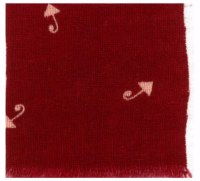
This was an inexpensive fabric colored with a synthetic dye and printed with white or black figures.
With the beginning of the 20th century cotton prints began to carry a wine colored red. The Sears catalog referred to the color as Claret or wine. The sample cards from the Simpson mills have called the color madeira. We might call it burgundy. This may have been produced by a synthetic dye, but it was a fast color and we can see it still today in many quilts that date from the 1890 to 1925 era. This fabric was cheap to produce and often had a white or black figure on the wine background. This almost purplish red is a wonderful clue to the 1890 to 1925 period.
Remember that when you are looking at a faded quilt if you see a lot of the colors have faded to pink or brown and even to a complete white more likely the dye was originally a red color. If you examine the various seams you may find residual color. Occasionally what originally appear to have been a tan and white color quilt might have been a red and white quilt!
Between 1875 to 1925 American fabric mills produced an inexpensive black on red ground. Some of the designs were small scale prints consisting of items like horseshoes, anchors and tennis rackets.
In large scale prints paisley cones and florals were produced between 1875 to 1925.
INTERESTING FACT: Did you know that Montgomery Ward and Sears sold large scale red and black prints called "robe prints" and were advertised for their suitability for quilts and comforters? They were also known as Garibaldi cloth a reference to the Italian hero whose followers wore red shirts and were known the "red shirts" in Italian politics.
REMEMBER: Garibaldi prints, robe prints or black on red prints are strong clues to the 1875 to 1925 time frame!
DID YOU KNOW: That in the Montgomery Ward catalogs one could purchase Turkey Red fabric for 27 1/2 cents per yard? Other red prints sold for 9 1/2 cents per yard!
GREENS
The color green though it is predominant in the color of nature is difficult to produce commercially. A fast green does not exist in a vegetable dye. As such the dyer often had to dye the fabric through the process called "over dying". By first dying a yellow color on fabric and then re-dye the fabric using blue the dyer could make a green color. The problem is that with this process the colors weren't fast and would often fade to either one of the single dye colors (either the blue or the yellow).
Another method that was used to produce a green fabric was to dye the yarn using the same over dying process. The yarn was then used to weave into the many different patterns as the fabric required. This method was used to produce such designs as stripes, checks, etc.
In fabric that had a flower pattern was much more difficult to produce the required green for the plants. One of the many methods used to was to first paint the plant one color (such as blue) and then over paint the color with a yellow. Or even vice versa. This process was called "overprinting'. Another way of producing the needed green color was to have someone actually color the stem or leaf with a yellow (or blue) and then re do it with the other color. This process is known as "penciling". The one problem is that the method used to make a perfect print (the "registration marks" did not always come out evenly. Therefore you some times had colors which over lapped. Occasionally the colors just seem to have been blobbed on and then process leaving a result that was far from spectacular. Another problem with this is that the colors would fade unevenly. One would have a color which would fade partly from a green to a blue to a yellow all in the same piece of fabric.
The color green was produced by overprinting the color yellow over blue (another process was to place blue over yellow). The problem was that this color combination was not stable (IE, the color would fade before the other color and leave it).
Between 1810 to 1820 a one stage process for the color green which used a secret mordant. Most fabric researchers feel that the process was more of a printing process using a mordant where a blue dye was mixed with a mordant for the color yellow. The only problem was the colors still faded.
The colors of the mineral greens were often cloudy, chalky and lifeless when compared to the vegetable dye. The only true greens came from synthetic dyes which were listed in dye manuals after 1875.
The knowledge of the process and problems with greens is useful because the presence of a cotton print with obvious overprinted or penciled green is a good clue that the fabric who printed before 1860 or so.
Over dyed greens appear as plains and as background in calico prints. The over dying is most apparent if one of the dyes is fading in blots rather than evenly across the surface. Over dying was common between 1840 to 1875 period.
Chrome Green the even, dark green that was used in many mid to late 19th century quilts, a combination of mineral and vegetable dye. Chrome green was an Indigo or Prussian Blue over dyed with chrome yellow that appears in quilts after 1840. This color had a reputation for fastness and the many red, white and green quilts.
Synthetic greens appeared after 1875. The synthetics were often fugitive (like most synthetics) they did not fade true but took a brownish cast when exposed to light and washing. Clues lie in the once matching thread and the fabric visible inside the seams or on back sides of an applique (where light has not done much damage).
Keep in mind that the synthetic greens faded to brown, tan or white. Throughout the last quarter of the 19th century and well into the 20th century.
One helpful clue for determining possible dates for quilts is the bluish pastel green that was very popular in the 1925 to 1950 era. Some researchers including Ruth Finley called it "colonial green". A Sears and Roebuck catalog from 1927 referred to the color shade of green as "Nile green". This shade became popular once again in the 1980's much to the joy of those who repair Depression era quilts.
Scrap quilts have occasionally been quilted with the Nile green shade in nineteenth century scrap quilts. NOTE: If the color Nile green as a print or a plain cotton, or a dominant color is evidence that the quilt is from the late 1920's or '30's. The Grandmother's Flower Garden patterns were found to have been in incorporated in applique pansies, dahlias using the Nile shade of green.
Indigo is a vegetable dye, is also one of the oldest known dyes to man. Indigo blue produced other shades and intensities of blues. Other dyes could produce the distinctive shade, but we associate the navy color as coming from the indigo color.
The indigo is a very fast color and was used by many weavers and quilt makers relied heavily on the indigo.
Dark blue plains and printed calicoes show up in quilts throughout the nineteenth century into the twentieth century. Keep in mind that since the dyeing of the indigo blue was complex most manufacturers printed indigo using a reserve technique the results of which are white figures on a navy background.
One thing to keep in mind is that the use of the many blues are good indicators of different eras. One being a vibrant blue became popular in the mid nineteenth century cottons. The color was known by several names: Prussian, Lafayette blue, Napoleon's blue, Berlin blue.
Lafayette blue appeared in plain cottons and in prints; common in florals, chintz-scale pillar prints and rainbow prints where the background is shaded from light to dark. A drab tan was overprinted on the blue. It was also used with other colors with electric results. Lafayette blue is a good clue to a date between 1930 and 1860.
Also keep in mind that light blues are NOT a good indicator of age with one exception: a light, vibrant blue that was popular as shirting fabric in the 1870s, '80s, '90s. The color is so vivid that it first appears to be a 20th century addition. HOWEVER, the checks, florals or geometrics printed on this blue violet on a white background are a definite clue to the last three decades of the nineteenth century.
Cadet blue became a very popular color. It was used from shirts to waists, aprons, blouses and children's clothing. Often this color was printed with a small white figure, dot or stripe, sometimes it is confused with the faded version of standard indigo or navy blue. Due to the popularity of cadet blue (also known as Calcutta blue) between the years 1890 to 1925 are an excellent indicator of the date of a quilt.
By the 1920's more light blues came into fashion and the Cadet and navy blue fell from fashion. Pastel colors were offered by the Sears catalog in 1932 and they also offered the cadet blue as well as some darker colors "for the older generation" who refused to change their clothing colors. The navy and cadet blue prints will be found in quilts made between the 1930s and 1940s.
AMANA BLUE...from Amana, Iowa. The history of Amana Blue comes from what are now called "The Amana Colonies". The Amana Colonies were set up by a Pietistic mystical Lutheran group the "Community of True Inspiration".. Eventually the German group moved to the United States during the 1842. After some traveling around the United States the Germans settled in Iowa where there was a substantial German and Dutch population. They established their own textile printing company using German blue dyes. The Amana Blue was a form of Navy Blue (very deep color). For more information on the Amana colors click 

The Amana Colonies became important as they established not only their own textiles, but also they established their own woolen mills (the are still operating to this day). The Calicoes that the Amana Colonies were important enough because they were in high demand by the public. Eventually the colony established their own sales people who traveled and sold the fabrics.
ORANGE AND YELLOWS
Yellow calicoes are hard for the novice to date because they were produced over a very long time from about the mid-nineteenth century until the 1980's.
One of the distinctive yellow found in quilts is a yellow-orange color similar to what we now call "Safety Yellow".